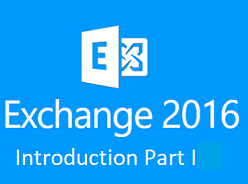introduction
Microsoft Exchange Server 2016 is the Microsoft Product of the mailing system and messaging platform
Exchange Server 2016 includes a number of advanced features for organizations to have a robust deployment of mailing system across multiple sites.
Exchange server is closely integrated into other Microsoft products such as
- Office, SharePoint,
- Skype for Business (formerly Microsoft Lync)
- and Office 365,
- Exchange Server 2013.
Many of the features in Exchange 2016 were first deployed in the cloud with Office 365 before coming to the on-premises version of Exchange. However, some features won’t be included which we will talk about it later
Exchange 2016 Roles
Exchange Server 2016 has just two server roles:
Mailbox server role
- this role will include the Mailbox and Client Access OWA roles from Exchange Server 2013.
- Compared to Exchange Server 2010 this role include all of the functions of the Client Access, Mailbox, Hub Transport, and Unified Messaging server roles.
- The Mailbox server role in Exchange Server 2016 is the only mandatory server role, and the consolidation reinforces the recommended practice since Exchange Server 2010 to deploy Exchange as a multi-role server instead of deploying individual roles to separate servers.
Edge Transport server role
- this role will be much the same as Edge Transport in previous versions of Exchange, designed to sit in perimeter networks DMZ and provide secure inbound and outbound mail flow for the organization.
- Edge Transport servers are not mandatory.
- Most of companies prefer to install NONE microsoft Edge as Mail security Like : Sonicwall Mail Security , Symantec mail Security , GFI , …etc
- in Pioneers.lab we will try to use None Microsoft Edge server from Diversity perspective
Exchange and other mailing system
ALL mailing system are based on SMTP like ;
- Psotfix
- Qmail
- sendmail
Database Availability Group (DAG)
The Database Availability Group (DAG) continues the high availability HA architecture for Databases with some enhancements that improve the performance, stability and functionality, Like :
- DAGs created without an IP address and administrative access point by default.
- Replay Lag Manager enabled by default.
- Database fail-over times reduced by 33% compared to Exchange Server 2013.
in pioneers LAB we will dedicate separate articles to talk about DAT as a part of High Availability
Exchange 2016 Features
- Outlook on the web (aka Outlook Web App): Outlook on the web is now updated with new web interface with faster email and people search.
- MAPI over HTTP: MAPI over HTTP was introduced in Exchange 2013. It is now the default protocol that Outlook uses to communicate with Exchange server. Exchange 2016 also supports Outlook Anywhere (RPC over HTTP) and is the fall back option for clients that do not support MAP over HTTP. If you are installing Exchange 2016 in existing Exchange 2013 environment then MAPI over HTTP will not be used by Outlook clients, instead Outlook Anywhere will be used.
- Document Collaboration: Exchange 2016 with Sharepoint 2016 allows Outlook on the web users to link and share documents stored on One Drive for business or on-premise SharePoint server instead of attaching the files. If you are running Office Online Server on-premise, you can edit documents using Outlook on the web.
- Data Loss Prevention: DLP is a feature that allows companies to protect sensitive information from being exposed, like credit card information, social security number and so on. In Exchange 2016, you can now identify and protect 80 different types of data using Data Loss Prevention and transport rules features. DLP has introduced new conditions and actions.
- In-place Archiving, retention and eDiscovery: You can now perform eDiscovery and hold on public folders in Exchange 2016. Exchange 2016 also introduces compliance search tool using which you can search unlimited number of mailboxes. However, compliance search feature is available only using Exchange Management Shell.

